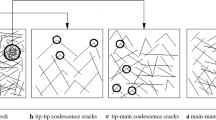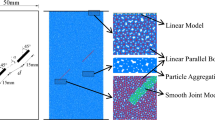Abstract
The fracture of rock mass is affected by different stress state in underground engineering. It is important to understand the crack propagation characteristics and stress distribution under different loading conditions. In this study, the FRACOD2D (the fracture propagation code) numerical modeling was conducted to analyze the propagation characteristics and stress distribution of rock-like material specimen under different loading conditions and crack geometric distribution. Crack propagation characteristics were distinct under different loading conditions, namely the tensile crack propagation under the uniaxial loading and shear crack propagation under the biaxial loading. In the uniaxial loading, the wing crack initiated at an angle of 90°, and then propagated along the maximum principal stress direction. The stress concentration occurred at the pre-existing crack tips. The coalescence of Model 1 rock bridge was caused by wing cracks and pre-existing cracks, while there was no coalescence occurred in the Model 2 or Model 3 rock bridge. Under the biaxial loading condition, shear cracks initiated at an angle of 150°, which developed from the pre-existing crack tips and propagated perpendicularly along the pre-existing cracks gradually. Moreover, secondary cracks propagated largely, whose stress concentration increased gradually with their propagation. Secondary shear cracks were interconnected, which led to the coalescence of Model 1 rock bridge The corrugated propagation of secondary cracks was observed instead of rock bridge coalescence in the Model 2 rock bridge. Pre-existing cracks of Model 3 propagated into two independent systems without cracks initiation in the rock bridge. Numerical modeling results were evidenced by laboratory tests.



Similar content being viewed by others
References
Bobet A, Einstein HH (1998a) Failure coalescence in rock-type material under uniaxial and biaxial compression. Int J Rock Mech Min Sci 35(7):863–888
Bobet A, Einstein HH (1998b) Numerical modeling of fracture coalescence in a model rock material. Int J Fract 92(3):221–252
Bocca P, Carpinteri A, Valente S (1990) Size effects in the mixed-mode crack-propagation-softening and snap-back analysis. Eng Fract Mech 35(1–3):159–170
Chan HCM, Li V, Einstein HH (1990) A hybridized displacement discontinuity and indirect boundary element method to model fracture propagation. Int J Fract 45(4):263–282
Hosseini-Tehrani P, Hosseini-Godarzi AR, Tavangar M (2005) Boundary element analysis of stress intensity factor K-I in some two-dimensional dynamic thermoelastic problems. Eng Anal Bound Elem 29(3):232–240
Janeiro RP, Einstein HH (2010) Experimental study of the cracking behavior of specimens containing inclusions (under uniaxial compression). Int J Fract 164:83–102
Lu XP, Wu WL (2006) A subregion DRBEM formulation for the dynamic analysis of two-dimensional cracks. Math Comput Model 43(1–2):76–88
Park CH, Bobet A (2009) Crack coalescence in specimens with open and closed flaws: a comparison. Int J Rock Mech Min Sci 46:819–829
Shen B (1993) Mechanics of fractures and intervening bridges in hard rocks. Ph.D. Thesis, Royal Institute of Technology
Shen B, Shi J (2016) Fracturing-hydraulic coupling in transversely isotropic rocks and a case study on CO2, sequestration. Int J Rock Mech Min Sci 88:206–220
Shen B, Stephansson O, Einstein HH, Ghahremanl B (1995) Coalescence of fractures under shear stresses in experiments. J Geophys Res 100(B4):5975–5990
Shen B, Kim HM, Park ES et al (2013) Multi-region boundary element analysis for coupled thermal-fracturing processes in geomaterials. Rock Mech Rock Eng 46(1):135–151
Shen B, Stephansson O, Rinne M (2014) Modelling rock fracturing processes. Springer, New York
Sun XZ, Shen B, Zhang BL (2018) Experimental study on propagation behavior of three-dimensional cracks influenced by intermediate principal stress. Geomech Eng 14(2):195–202
Wong RHC, Chau KT (1998) Crack coalescence in a rock-like material containing two cracks. Int J Rock Mech Min Sci 35(2):147–164
Wong LNY, Einstein HH (2009a) Crack coalescence in molded gypsum and carrara marble: part 1. Macroscopic observations and interpretation. Rock Mech Rock Eng 42(3):475–511
Wong LNY, Einstein HH (2009b) Systematic evaluation of cracking behavior in specimens containing single flaws under uniaxial compression. Int J Rock Mech Min Sci 46(2):239–249
Xu C, Fowell RJ (1994) Stress intensity factor evaluation for cracked chevron notched Brazilian disc specimens. Int J Rock Mech Min Sci Geomech Abstr 31(2):157–162
Yang SQ, Yang DS, Jing HW et al (2012) An experimental study of the fracture coalescence behaviour of brittle sandstone specimens containing three fissures. Rock Mech Rock Eng 45:563–582
Zhang XP, Wong LNY (2012) Cracking processes in rock-like material containing a single flaw under uniaxial compression: a numerical study based on parallel bonded-particle model approach. Rock Mech Rock Eng 45(5):711–737
Zhao W, Huang R, Yan M (2015) Mechanical and fracture behavior of rock mass with parallel concentrated joints with different dip angle and number based on PFC simulation. Geomech Eng 8(6):757–767
Acknowledgements
This study was supported by National Natural Science Foundation of China (No. 51704152), Taishan Scholar Talent Team Support Plan for Advantaged and Unique Discipline Areas, Key Laboratory Open Foundation of Deep Coal Mine Excavation Response and Disaster Prevention and Control (No. KLDCMERDPC17108), National Key R&D Program of China (No. 2017YFC0804202) and Anhui Provincial Natural Science Foundation (No. 1808085QE177).
Author information
Authors and Affiliations
Corresponding authors
Rights and permissions
About this article
Cite this article
Sun, X.Z., Li, J.Z. Numerical Study on Crack Propagation Characteristics Under Different Loading Conditions by FRACOD2D Approach. Geotech Geol Eng 37, 61–69 (2019). https://doi.org/10.1007/s10706-018-0589-5
Received:
Accepted:
Published:
Issue Date:
DOI: https://doi.org/10.1007/s10706-018-0589-5




